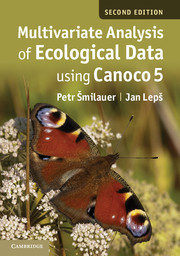Book contents
- Frontmatter
- Contents
- Preface
- 1 Introduction and data types
- 2 Using Canoco 5
- 3 Experimental design
- 4 Basics of gradient analysis
- 5 Permutation tests and variation partitioning
- 6 Similarity measures and distance-based methods
- 7 Classification methods
- 8 Regression methods
- 9 Interpreting community composition with functional traits
- 10 Advanced use of ordination
- 11 Visualising multivariate data
- 12 Case study 1: Variation in forest bird assemblages
- 13 Case study 2: Search for community composition patterns and their environmental correlates: vegetation of spring meadows
- 14 Case study 3: Separating the effects of explanatory variables
- 15 Case study 4: Evaluation of experiments in randomised complete blocks
- 16 Case study 5: Analysis of repeated observations of species composition from a factorial experiment
- 17 Case study 6: Hierarchical analysis of crayfish community variation
- 18 Case study 7: Analysis of taxonomic data with discriminant analysis and distance-based ordination
- 19 Case study 8: Separating effects of space and environment on oribatid community with PCNM
- 20 Case study 9: Performing linear regression with redundancy analysis
- Appendix A Glossary
- Appendix B Sample data sets and projects
- Appendix C Access to Canoco and overview of other software
- Appendix D Working with R
- References
- Index to useful tasks in Canoco 5
- Subject index
14 - Case study 3: Separating the effects of explanatory variables
Published online by Cambridge University Press: 05 May 2014
- Frontmatter
- Contents
- Preface
- 1 Introduction and data types
- 2 Using Canoco 5
- 3 Experimental design
- 4 Basics of gradient analysis
- 5 Permutation tests and variation partitioning
- 6 Similarity measures and distance-based methods
- 7 Classification methods
- 8 Regression methods
- 9 Interpreting community composition with functional traits
- 10 Advanced use of ordination
- 11 Visualising multivariate data
- 12 Case study 1: Variation in forest bird assemblages
- 13 Case study 2: Search for community composition patterns and their environmental correlates: vegetation of spring meadows
- 14 Case study 3: Separating the effects of explanatory variables
- 15 Case study 4: Evaluation of experiments in randomised complete blocks
- 16 Case study 5: Analysis of repeated observations of species composition from a factorial experiment
- 17 Case study 6: Hierarchical analysis of crayfish community variation
- 18 Case study 7: Analysis of taxonomic data with discriminant analysis and distance-based ordination
- 19 Case study 8: Separating effects of space and environment on oribatid community with PCNM
- 20 Case study 9: Performing linear regression with redundancy analysis
- Appendix A Glossary
- Appendix B Sample data sets and projects
- Appendix C Access to Canoco and overview of other software
- Appendix D Working with R
- References
- Index to useful tasks in Canoco 5
- Subject index
Summary
Introduction
In many cases, the effects of several explanatory variables need to be separated, even when the explanatory variables are correlated. The example below comes from a field fertilisation experiment (Pyšek & Lepš 1991). A barley field was fertilised with three types of nitrogen fertiliser (ammonium sulphate, calcium-ammonium nitrate, and liquid urea) and two different total nitrogen doses. For practical reasons, the experiment was not established in a correct experimental design, the plots are pseudoreplicates, which limits correct statistical inference (see Section 3.4). The experiment was designed by hydrologists to assess nutrient runoff and, consequently, smaller plots were not practical. In 122 plots, the species composition of weed community was recorded as classical Braun-Blanquet relevés (for the calculations, the ordinal transformation was used, i.e. numbers 1–7 were used for grades of the Braun-Blanquet scale: r, +, 1, .…, 5). The percentage cover of barley was estimated in all relevés.
The authors expected the weed community to be influenced both directly by fertilisers and indirectly through the effect of crop competition. Based on the experimental manipulations, the overall fertiliser effect can be assessed. However, barley cover is highly correlated with fertiliser dose. As the cover of barley was not manipulated, there is no direct evidence of the effect of barley cover on the weed assemblages. But the data enable us to partially separate the direct effects of fertilisation from the indirect effects of barley competition. This is done in a way similar to the separation of the effects of correlated predictors on the univariate response in multiple regression. The separation can be done using the variable of interest as an explanatory variable and the other one as a covariate.
Information
- Type
- Chapter
- Information
- Multivariate Analysis of Ecological Data using CANOCO 5 , pp. 246 - 257Publisher: Cambridge University PressPrint publication year: 2014
